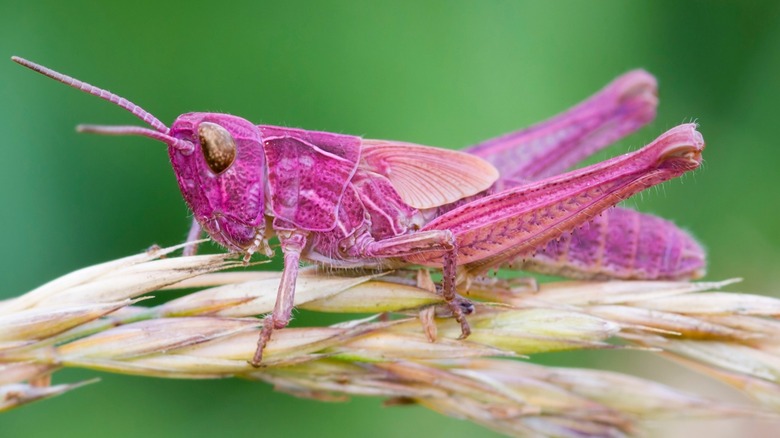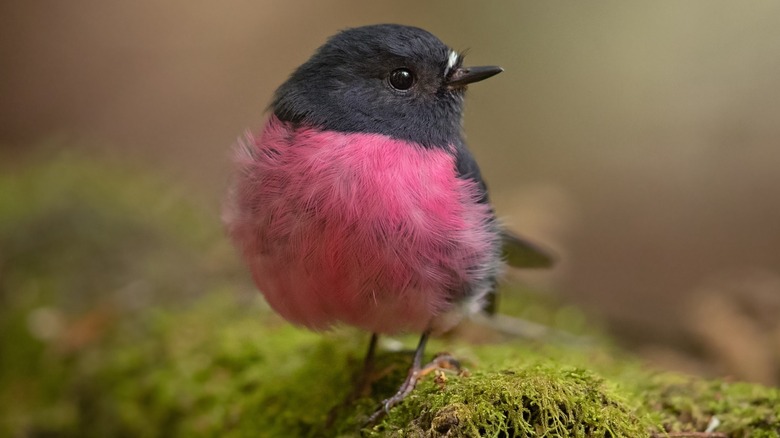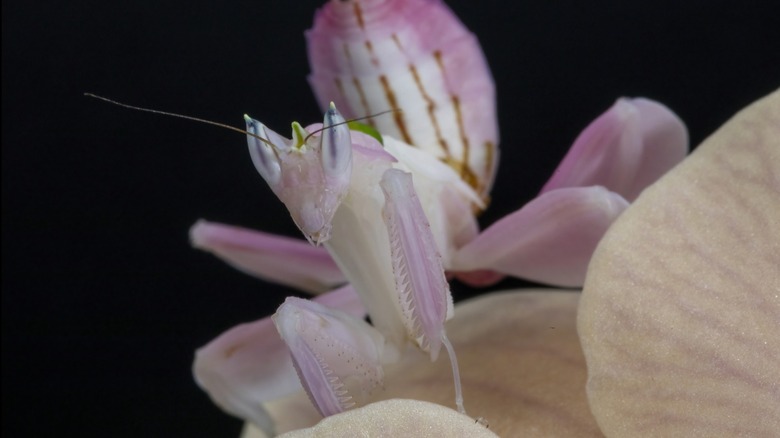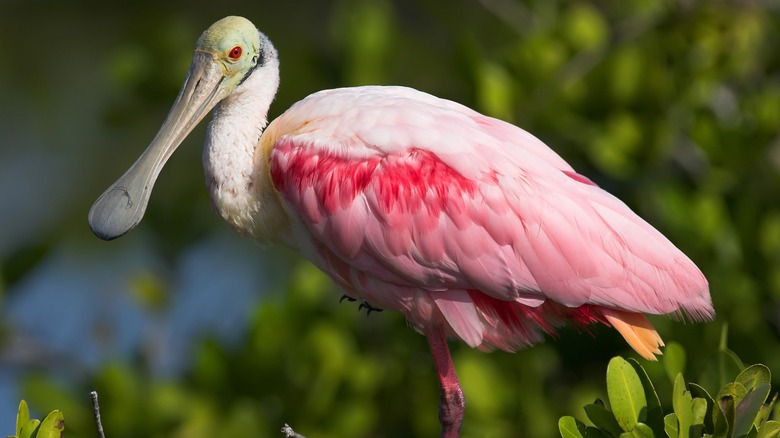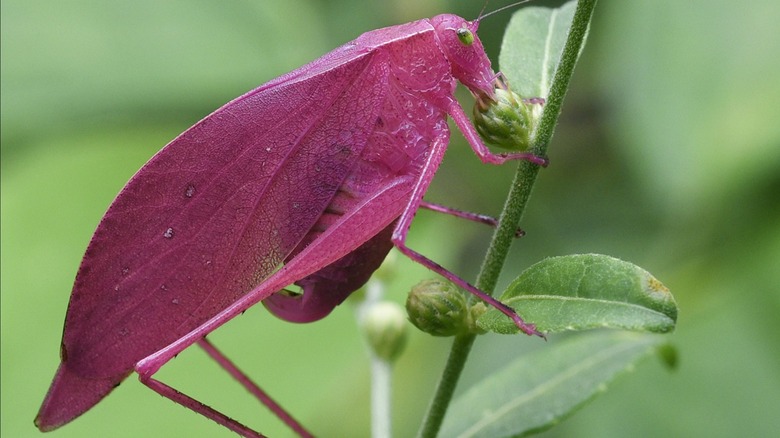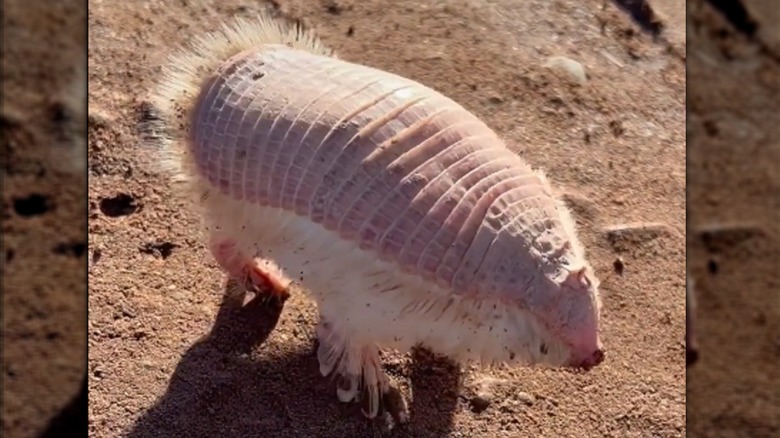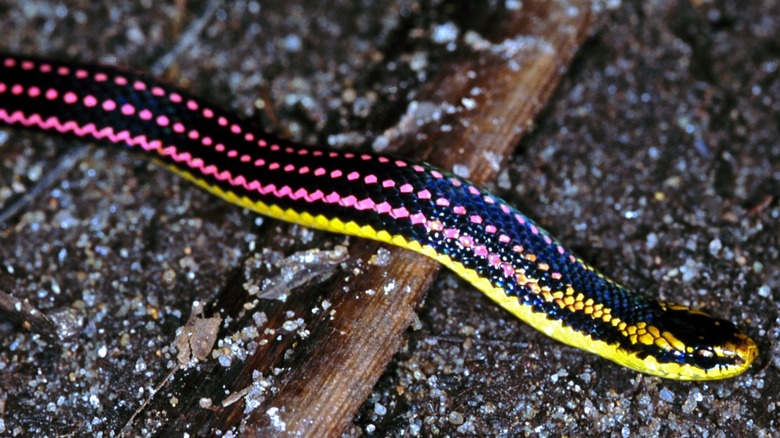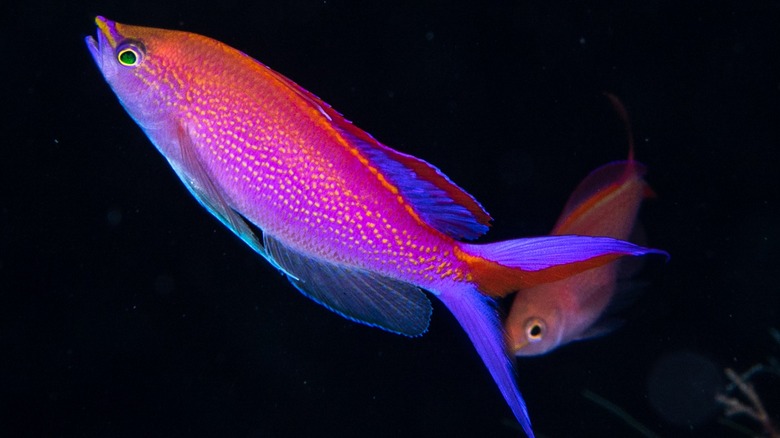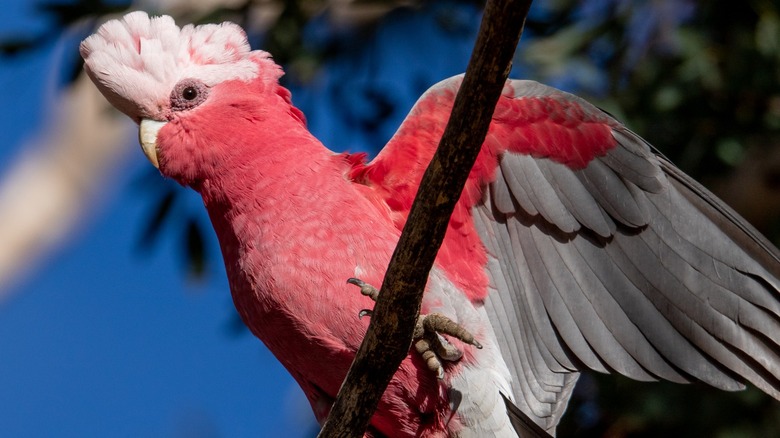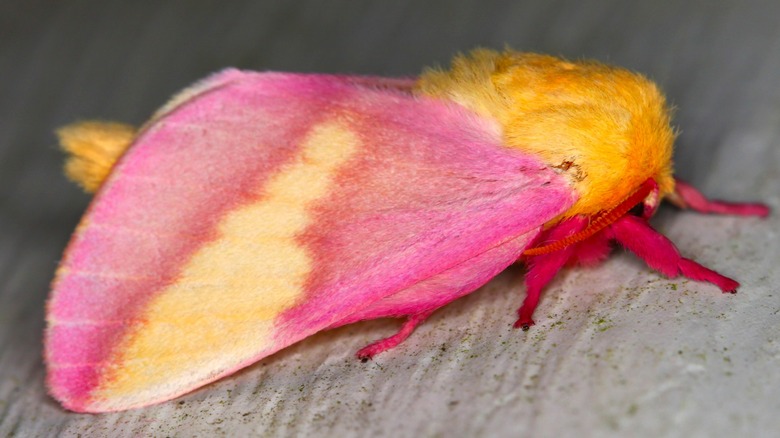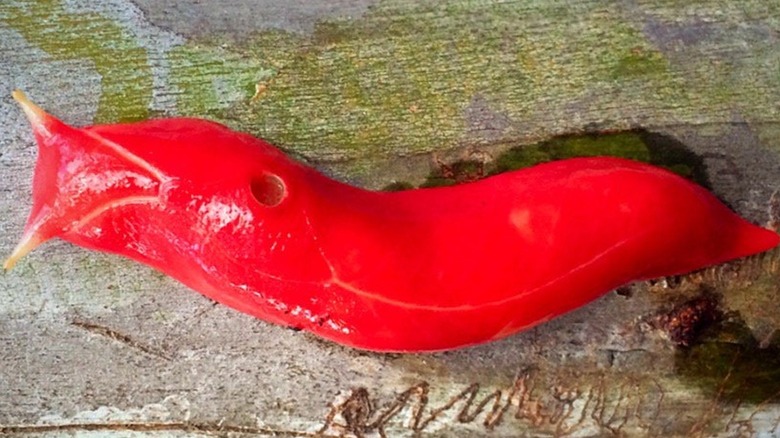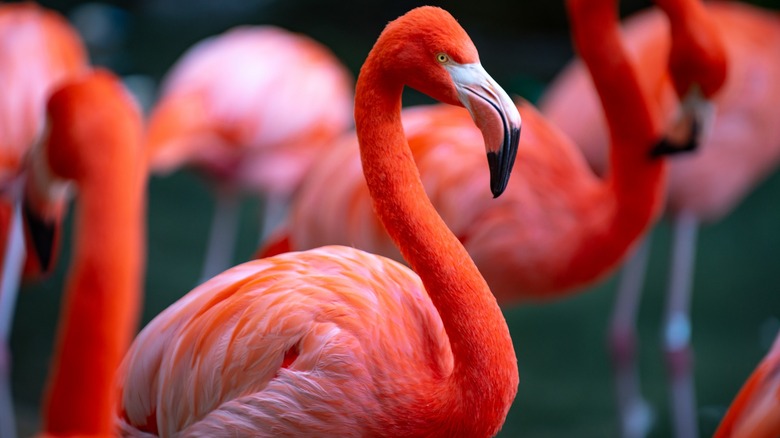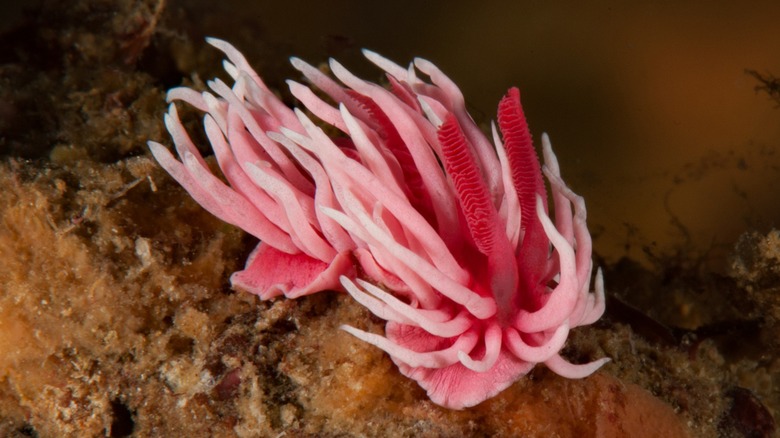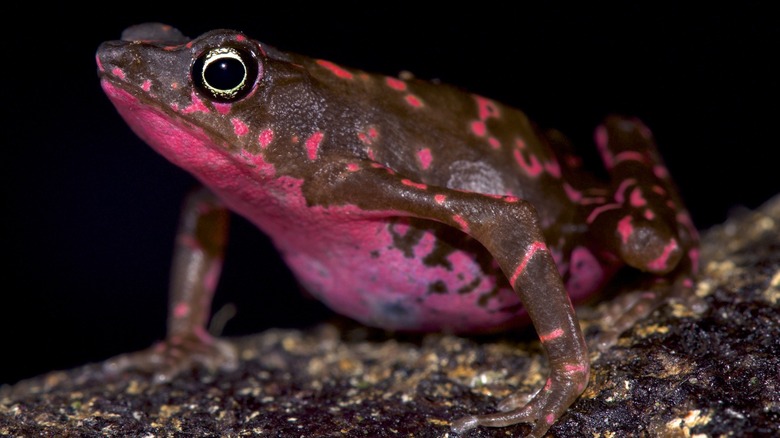Pink Animals You'll Find In The Wild
Pink is one of the most eye-catching and iconic colors in modern popular culture. It's the color of Valentine's Day, sunsets, and, of course, Barbie. But, like the fantastical things it often symbolizes, pink is made-up. It's not one of the colors found in a rainbow, meaning there is no such thing as a pink wavelength of light. What our eyes perceive as pink is actually a blend of red and violet, sometimes with hints of blue and orange.
Despite its synthetic vibe, the pink color combination occurs pretty frequently in nature. It's a common hue for flowers, and, in fact, the name "pink" was inspired by a small carnation species. It's also an old color combination. According to a 2018 study published in PNAS, bright pink pigments called porphyrins — formed by the fossilized chlorophyll of cyanobacteria — were found in ancient West African rocks, meaning pink has been around for at least 1.1 billion years and is therefore the oldest color in the geologic record.
Still, pink is not a common color in the animal kingdom — and when it does occur, it's pretty exciting. Pink coloration in animals is usually the result of natural pigments, like carotenoids and porphyrins, or the reddish iron-rich protein hemoglobin found in the blood. From hot pink grasshoppers to rosy robins to mysterious tiny armadillos, here are a few pink animals you'll find in the wild.
Pink robin
It doesn't get much cuter than the pink robin. Males of this small songbird species have shockingly bright pink breasts that contrast with their slate gray heads, throats, and backs. This coloration, along with their small white forehead spots, likely helps males advertise to mates in dim-lit environments. Females, meanwhile, have more subdued earth-toned plumage, which provides beneficial camouflage during nesting — though they still have a hint of pink on their bellies.
While the exact pigments responsible for the robin's unique pink plumage are still unknown, it's likely due to carotenoids. As biologists noted in a 2006 study published in Annales Zoologici Fennici, two types of carotenoid pigments were responsible for the striking red plumage of the pink robin's close relative, the red-capped robin. In birds, bright coloration is an advertisement of fitness, as only the healthiest individuals are able to get enough extra pigments from their diet to produce brightly colored feathers. Females, therefore, likely seek out the pinkest males they can find when selecting a mate.
Pink robins live only in the cool temperate forests and moist eucalyptus gullies of southeastern Australia but prefer very wet and densely vegetated rainforest habitats to breed. Much to many photographers' chagrin, they are shy and secretive birds, spending most of their days hunting insects from the safety of thick undergrowth. Oftentimes, their high-pitched chattering calls are the only sign that they are around.
[Featured image by JJ Harrison via Wikimedia Commons | Cropped and scaled | CC BY-SA 4.0]
Malaysian orchid mantis
The praying mantis world is all about girl power. Not only are females significantly larger than males, which can lead to his becoming a snack during mating, but sometimes coloration also differs radically between the sexes. This is definitely the case for the orchid mantises of Southeast Asia, the adult females of which come in vibrant shades of yellow, white, and, in the case of the Malaysian orchid mantis, pink. To complete the look, female orchid mantises also feature widened petal-like legs, green and yellow accents, and floral patterns for good measure.
As their name suggests, these seemingly flamboyant lady insects blend in perfectly when perched on brightly colored flowers, rendering them invisible to both predators and their would-be prey: insect pollinators. Like many arthropods, females are bigger and hungrier than their male counterparts due to their egg-laying responsibilities. According to a 2016 study published in Scientific Reports, female orchid mantises devised a clever solution to their voracious appetites.
They evolved bright coloration as a means of hunting larger prey, such as hefty pollinating insects like bees and butterflies, leaving the much smaller and drabber males with only greater skittishness and agility. A 2014 study published in The American Naturalist demonstrated that female Malaysian orchid mantises were even able to lure insects in the absence of flowers, meaning their deception is more sophisticated than mere camouflage and is actually a form of aggressive mimicry. Owing to their feminine beauty, Malaysian orchid mantises have become popular pets.
Amazon River dolphin
Not many mammals are truly pink, but male Amazon River dolphins sure are. Also called botos, these unique 6-to-9-foot cetaceans live in the freshwater lakes and rivers of South America's Amazon and Orinoco River basins where they feed on catfish and other fish, crabs, frogs, and turtles. Like all dolphins, they are highly intelligent and even have brains with a capacity 40% greater than our own. The species' trademark pink coloration is most pronounced in mature males but occurs in all adults and is highly variable.
Curiously, all Amazon River dolphins are born gray and gradually develop pink patches — or, rather, lose their dark pigmentation — as they mature. According to a 2006 study published in Marine Mammal Science, advanced age, repeated abrasions, and scar tissue from physical combat all contribute to a dolphin's pink hue. Males, in particular, wear their injuries like a badge of honor. The brighter pink a male is, the more desirable he is to females, likely because his color advertises his maturity. Temperature, water clarity, and capillary flushing due to excitement also influence the intensity of pink coloration.
Unfortunately, these fascinating pink creatures face several hardships in modern times. Mercury pollution from mining and damming along waterways threaten the species' limited habitat. Sometimes, people also intentionally kill the dolphins as they are viewed as competition for fish. As a result, Amazon River dolphins are now considered an endangered species.
Roseate spoonbill
Roseate spoonbills are bizarre birds with several unusual features. They stand almost 3 feet tall, gather in large flocks in North and South America, and have long spoon-shaped bills. But what most people notice first about these birds is their shocking pink color. As their name suggests, adult roseate spoonbills are predominantly a soft baby pink with bright coral shoulders and accents. So, just how do they come by this dramatic coloration?
The answer lies in the aquatic food chain. Spoonbills are wading birds that spend most of their time using their unique bills to sift through shallow water in search of their favorite prey: fish and small aquatic invertebrates. Some of these creatures, like shrimp and other crustaceans, contain red and orange pigments called carotenoids. In fact, one especially delicious brine shrimp species, Artemia salina, is responsible for much of the birds' pink coloration – and it, in turn, receives its pink color from feeding on microalgae, which produces the carotenoid astaxanthin as a type of sunblock.
Over time, the color concentrates in the birds' skin and plumage. Chicks hatch a fluffy white, but their feathers gradually become tinted pink as they receive crustacean foods from their parents. Unfortunately, their beautiful coloration came at a price during the plume trade of the 1800s. Roseate spoonbill feathers were in high demand as ornamentation for ladies' hats, and the species was nearly hunted to extinction in the United States. Luckily, they have made a strong comeback.
Pink grasshoppers and katydids
Sometimes, grasshoppers and their cousins, katydids, are discovered in radical pink hues straight out of the 1980s. In fact, one such insect – a hot-pink green meadow grasshopper found in the U.K. in July 2023 – went viral for looking like a long-lost Barbie accessory. But, as you might expect, "screaming pink" is not really an ideal color for these insects, as it makes them much more noticeable to predators. So, what gives?
Natural selection in grasshoppers and katydids typically favors colors like green, brown, gray, and sometimes yellow. That's because these earthier tones allow the insects to camouflage more effectively against the ground or vegetation. Currently, the most accepted explanation is that pink coloration in these insects is due to a type of genetic mutation called erythrism that alters the normal expression of color pigments.
A study conducted at the New Orleans Audubon Butterfly Garden and Insectarium in the mid-2000s (via Scientific American) found that, in breeding different color morphs of the oblong-winged katydid (pictured), pink coloration surprisingly turned out to be dominant while the more common green coloration is recessive. This means that, while selection currently strongly favors green, other colors — such as orange and pink — still persist, though they are extremely rare. That's because, in nature, it's good to have options as environmental conditions are always changing. While they likely lead short lives today, there could come a time when being pink is advantageous.
Pink fairy armadillo
If there's a contest for the cutest pink animal out there, the pink fairy armadillo would probably win. At just 6 inches long, it fits neatly in a hand, has comically large feet, and features a pastel pink shell above and long white fur below. It's a hard creature to find, what with it being nocturnal and spending most of its life underground in the desert regions of its native central Argentina. In fact, one armadillo researcher spent 13 years working in its habitat and still never saw one!
The elusive creature's pale pink color comes from the capillary-rich skin on its soft shell, which it uses more for regulating body temperature than for physical protection as other armadillos do. The many small blood vessels just beneath the skin's surface give the creature an overall pink hue, which changes in intensity as the capillaries constrict and expand to heat and cool the animal — an important ability in its extreme desert environment.
Pink fairy armadillos are perfectly suited for life underground, using their large feet and claws to dig quickly into the sand and their armor to create stable tunnels. They feed on plants, worms, and ants, and, as researcher Mariella Superina explained to Atlas Obscura, seem to have very specific tastes and needs that make them especially difficult to keep in captivity. Asides from these scant facts, shockingly little is known about these mysterious animals, which are the world's smallest — and most difficult to study — armadillos.
Liophidium pattoni
Despite the fact that it lacks a common name, this relatively new-to-science snake is remarkably beautiful. According to the 2010 study published in Salamandra in which the species was formally described, Liophidium pattoni was first observed crossing a sunny path within the rainforests of Madagascar in 2009. Researchers immediately recognized that the snake was a new species because, well, it was strikingly gorgeous. Predominantly black, this 16-inch snake features bright yellow facial stripes and tiny hot pink spots that gradually blend into gray speckles on its back. It also has a bright pink underbelly patch near its tail.
Because this snake is not venomous or aggressive, researchers believe that its unusual bright markings are a form of Batesian mimicry — that is, its coloration mimics that of a venomous or poisonous species so would-be predators will hopefully leave it alone, too. In this case, the snake is likely mimicking local millipedes, which are marked by bright red spots to warn predators of their toxins. Because pink is technically a tint of red, the snake's hot pink and bright yellow markings probably function as warning coloration. Liophidium pattoni lives in rainforests where it hunts lizards and other small prey by day, likely relying on its colorful appearance to keep it safe. Surprisingly, little else is known about this fascinating snake.
[Featured image by Bernard DUPONT from FRANCE via Wikimedia Commons | Cropped and scaled | CC BY-SA 2.0]
Princess anthias
If Barbie had a fish, the aptly named princess anthias would certainly be her top choice. This small reef fish is popular in the saltwater aquarium trade for one reason: It's bubblegum pink and covered in tiny yellow speckles and "scribbles" that look a lot like glitter. Native to deepwater reefs off the coast of northern Australia and around islands in the West Pacific, the princess anthias lives in high-energy schools and primarily feeds on plankton at depths of 19 to 228 feet.
In its preferred deep water, the species' bright pink color appears almost blue. This is because colors with longer wavelengths and less energy, like red, get filtered out quicker when penetrating water, eventually leaving only those colors with shorter wavelengths and greater energy, like violet and blue, that are able to travel through to deep water. Because pink is typically a combination of red and violet, it makes sense that only the more purple and blue aspects of the color remain visible at greater depths.
Both male and female princess anthias fish are pink but males feature slightly brighter coloration and long blue-tipped streamer-like tails. However, the species exhibits protogynous hermaphroditism, meaning females can change into males as needed to uphold the complex social hierarchy. For example, if the dominant territorial male in the school dies, the largest female will become male and assume the role. Life as a princess anthias is always competitive, with each fish aggressively maintaining its place in the school.
Galah
While there are a few pink parrots out there, the galah takes it to another level. These medium-sized cockatoos live in large, noisy flocks throughout their native Australia. Owing to their sociable and playful personalities, they are also popular pets the world over. Both adult male and female galahs have deep rosy pink breasts, necks, and wing undersides, and lighter cotton candy-colored crests, which contrast with their dark gray backs. In fact, the sexes are only distinguishable by their eye color: Females have bright pink eyes while those of males are dark brown.
Scientists aren't exactly sure why galahs are pink, but the bright coloration may play a role in mate selection. Even though "galah" is an Aboriginal word for "fool," these birds are members of the parrot family and are actually quite smart. They live in flocks with complex social structures, typically mate for life, vocalize using individualized contact calls as names, and are known to mob aerial predators like falcons using a "swirling tornado flock" method, in which hundreds of birds circle together to confuse the attacker.
However, their intelligence also makes them a nuisance to farmers, as they often raid crops and can even undo stitches on grain storage sacks. Still, the galah is one of only a few parrot species that has adapted well to life alongside humans, and their numbers are actually increasing – especially in areas with abundant food and water resources.
Rosy maple moth
The rosy maple moth of eastern North America's temperate deciduous forests doesn't seem like a real creature – and it certainly doesn't fit most peoples' description of a moth. Not only are these small winged insects super fuzzy, but, unlike many other moth species, they are bright pink and yellow rather than drab and earth-toned. The moths' pink coloration is variable, with some individuals being very bright and others appearing more washed out with faint pink accents.
Though they are extremely noticeable at porch lights, these insects are actually remarkably well-camouflaged against their chosen resting spot: among the pink samaras — or winged fruits — of maple trees. The bright markings also serve as warning coloration to deter would-be predators. With a wingspan of only 2 inches, they are one of the smallest members of the giant silk moth family, Saturniidae, which also includes the iconic luna moth and massive Atlas moth.
Still, the moths make quite a splash when they emerge from the leaf litter and take flight in late afternoons during the summer months. Adult moths lack mouthparts and are therefore unable to feed. They pretty much live just long enough to find a mate using their pheromones and feathery antennae, breed, and lay eggs. The green caterpillars, meanwhile, spend all summer munching on maple and oak leaves before retreating underground, pupating over winter, and readying themselves to emerge during the next warm season and start the cycle over again.
Mount Kaputar pink slug
If Barbie had a slug — okay, okay. She probably wouldn't have a slug. But if she did, it would for sure come from Mount Kaputar National Park in New South Wales, Australia. Amazingly, hot pink slugs that can grow to the unimaginable size of 8 inches long and 2 inches wide can be found on the remote former volcano Mount Kaputar. The rainforest mountaintop acts as a "sky island," a unique ecosystem that is isolated from other similar habitats by a "sea" of impassable terrain. Because the slugs cannot crawl across the vast dry expanse surrounding their mountain home, they have become genetically isolated there.
Hundreds of the giant pink slugs feed on lichen, fungi, moss, and algae in the treetops at night, then crawl down to hide in moist rock cracks during the hot day. One theory for their vibrant coloration is that it helps them blend in with fallen pink snow gum leaves on the forest floor — but researchers still aren't exactly sure why the slugs are pink.
Biologists were especially worried about the rare pink slugs during the extreme wildfires that besieged Australia in 2019. Because the land mollusks are slow-moving and unable to escape, must stay constantly moist to survive, and only live at one location, the species is especially at risk of extinction by fire. Luckily, it seems that the slimy creatures sought refuge in deep crevices and many managed to survive.
Flamingos
Flamingos are the poster child for "pink animals." Tall wading birds with long necks, longer legs, and unusual-looking downturned bills, all six species of flamingo gather in large flocks to feed on algae, mollusks, and crustaceans found in shallow pools, stirring up goodies with their feet and bills. Red-hued carotenoid pigments in their tiny prey concentrate in their tissues, giving them their famous pink color. Curiously, every flamingo species sequesters a unique pigment, giving each a slightly different pink hue.
The name "flamingo" is likely a version of the Spanish word "flamenco," which means "fire" — a nod to the birds' bright flame-like pink and coral feathers. And it's not just their plumage. Every single part of a flamingo is pink, including its skin and blood. These birds literally bleed pink — even in their social lives. All adult flamingos use their pink plumage to signal health, fitness, and dominance to prospective mates and other flock members, with the pinkest birds having the highest status and greatest health, and therefore being the most desirable.
Pink coloration in flamingos is most intense during the breeding season when the birds have greater access to pigmented food and fades to almost white after the taxing processes of molting and raising young. Chicks hatch downy and gray, but slowly acquire their color after being fed a special bright red pigment-rich concoction called "flamingo milk" produced by their parents. Zoos typically supplement their flamingos' food with carotenoids to keep them as pink as possible year-round.
Hopkins' rose nudibranch
If you're wondering just what in the heck a nudibranch is, fear not: It's basically just a fancy word for "naked gill" and refers to a group of shell-less sea slugs. While underwater slugs might not seem too exciting, nudibranchs are often brightly colored and covered in bizarre doo-dads, giving them a flashy appearance meant to warn would-be attackers to stay away. They also taste bad because they sequester toxins from their prey as a defense mechanism, and, as a result, have few natural predators — besides each other.
The Hopkins' rose nudibranch is 1 inch long, bright fuchsia pink, and covered in tentacle-like protuberances that are actually its feathery gills. It livens up the tidepools of western North America's rocky coasts, which are otherwise decidedly cold and un-tropical. Like all nudibranchs, it's carnivorous and feeds only on an equally unusual colonial animal species called the pink encrusting bryozoan, which produces the carotenoid pigment hopkinsiaxanthin that gives it its namesake rosy hue.
The Hopkins' rose nudibranch is hermaphroditic, meaning any two sea slugs can mate and both will proceed to lay pink ribbon-like spirals of eggs as a result. Sometimes, these bizarre creatures make the news when changing currents carry their free-floating larvae toward the shore rather than out to sea, creating sudden and dramatic pink "blooms" of them on the California coast. Climate change is also warming the coastal waters, allowing the species to expand its range farther north each year.
Purple harlequin toad
Despite its common name, this small species of toad is primarily black with hot pink swirls on its back and a neon pink throat and belly. It belongs to the colorful South and Central American genus Atelopus, which are commonly called harlequin toads. Nicknamed "jewels of the Neotropics" and "clown frogs," harlequin toads face many threats, including habitat loss, climate change, and a deadly introduced fungus. These unique toads live along rainforest streams, and some species adorably use their arms to "wave" at one another rather than trying to vocalize over the loud rushing water.
Like many amphibians — including the famous poison dart frogs — the purple harlequin toad's bright coloration warns predators to leave it alone as it harbors dangerous toxins in its skin. And for darn good reason. According to a 2022 study published in Toxicon, harlequin toads can release several toxic compounds from small glands located throughout their bodies. In humans, these toxins can cause heart problems, paralysis, and, in high enough doses, death.
The pink-splattered purple harlequin toad, which lives only in a small section of high-elevation rainforest in French Guiana, is especially imperiled due to its very restricted range. What's worse, many are also captured for the exotic pet trade because of their unique beauty, further endangering the species. Efforts are currently being made to breed the toads in captivity to both boost wild populations and disincentivize their illegal capture.
